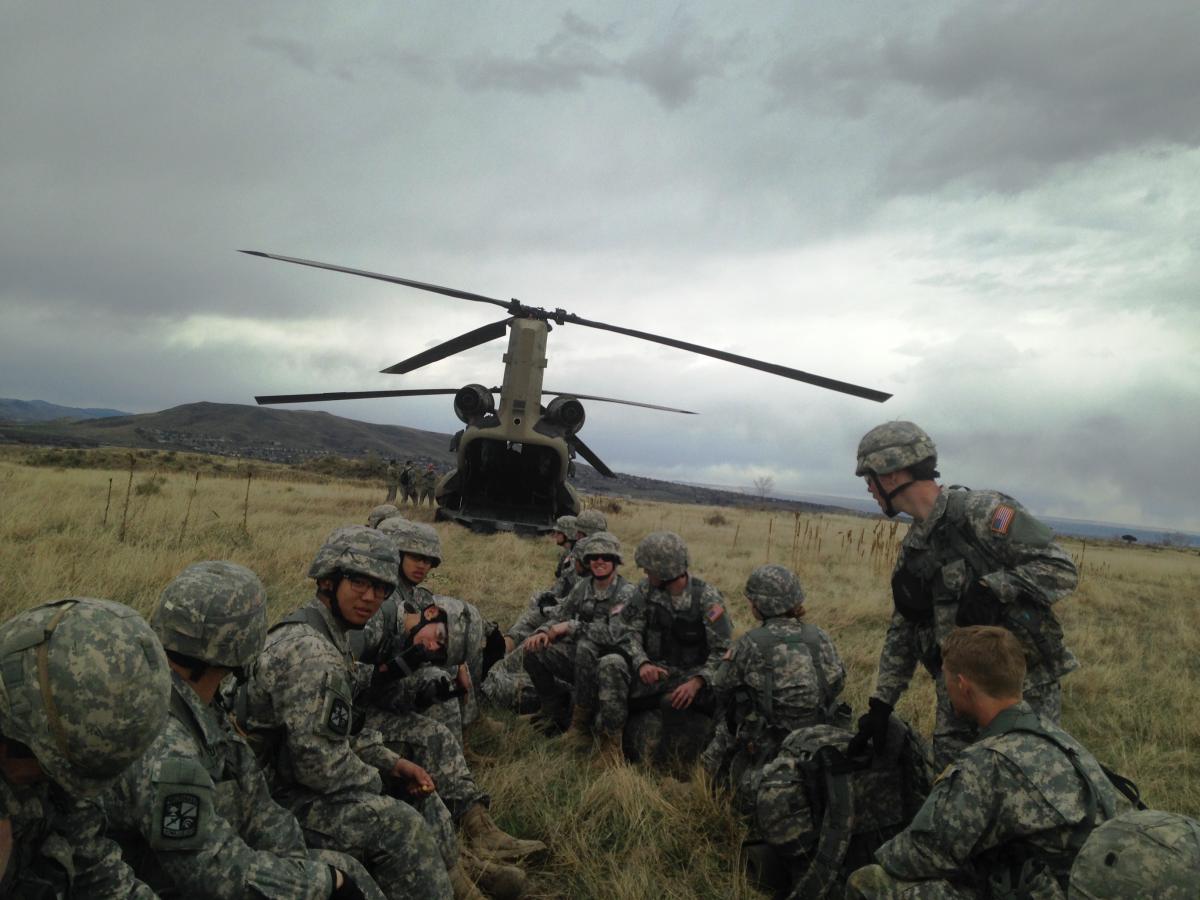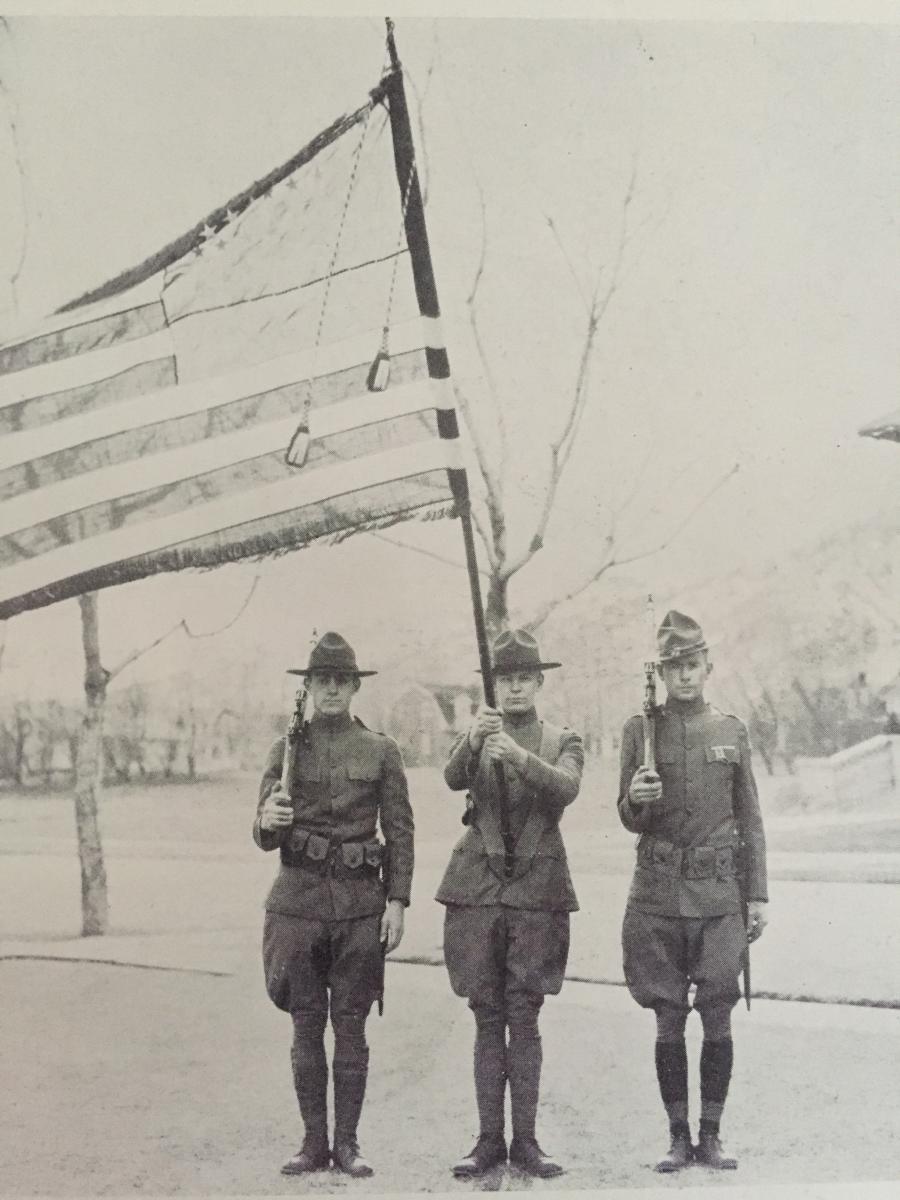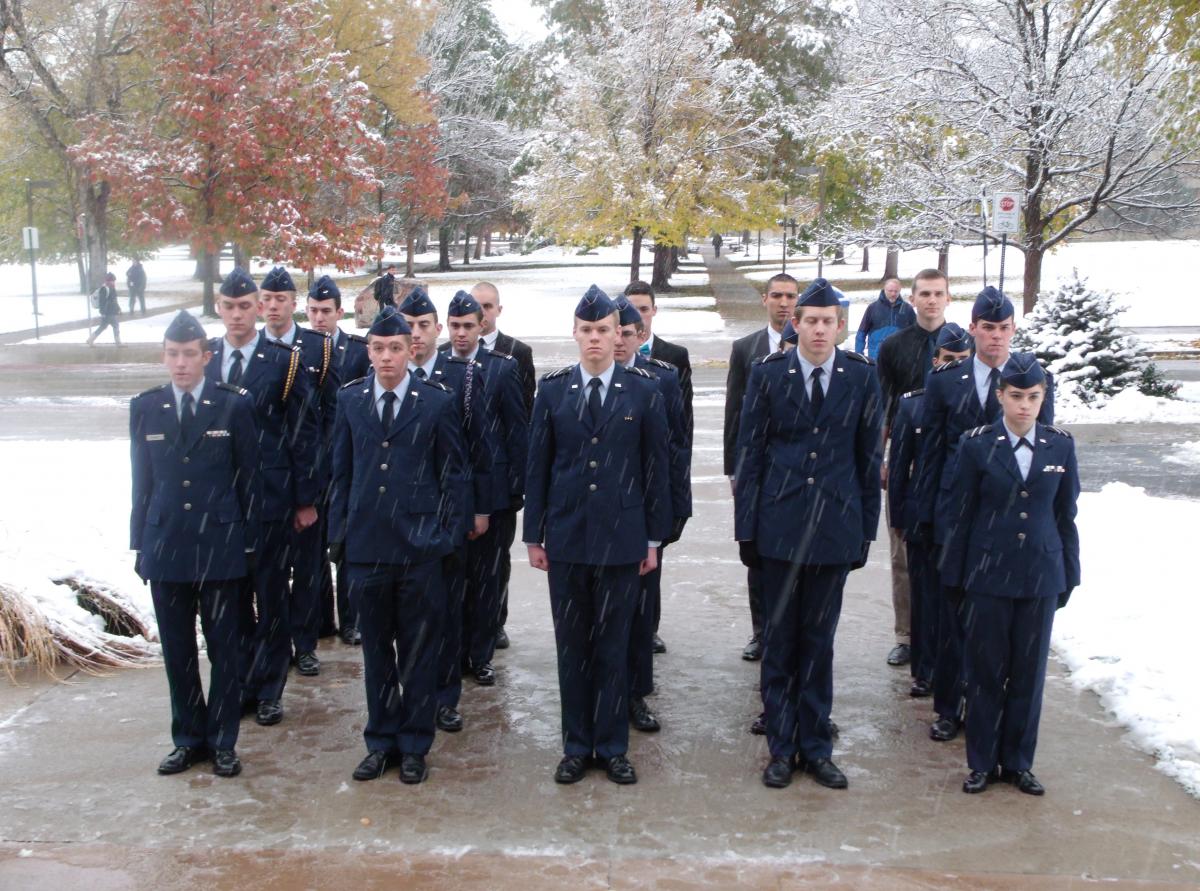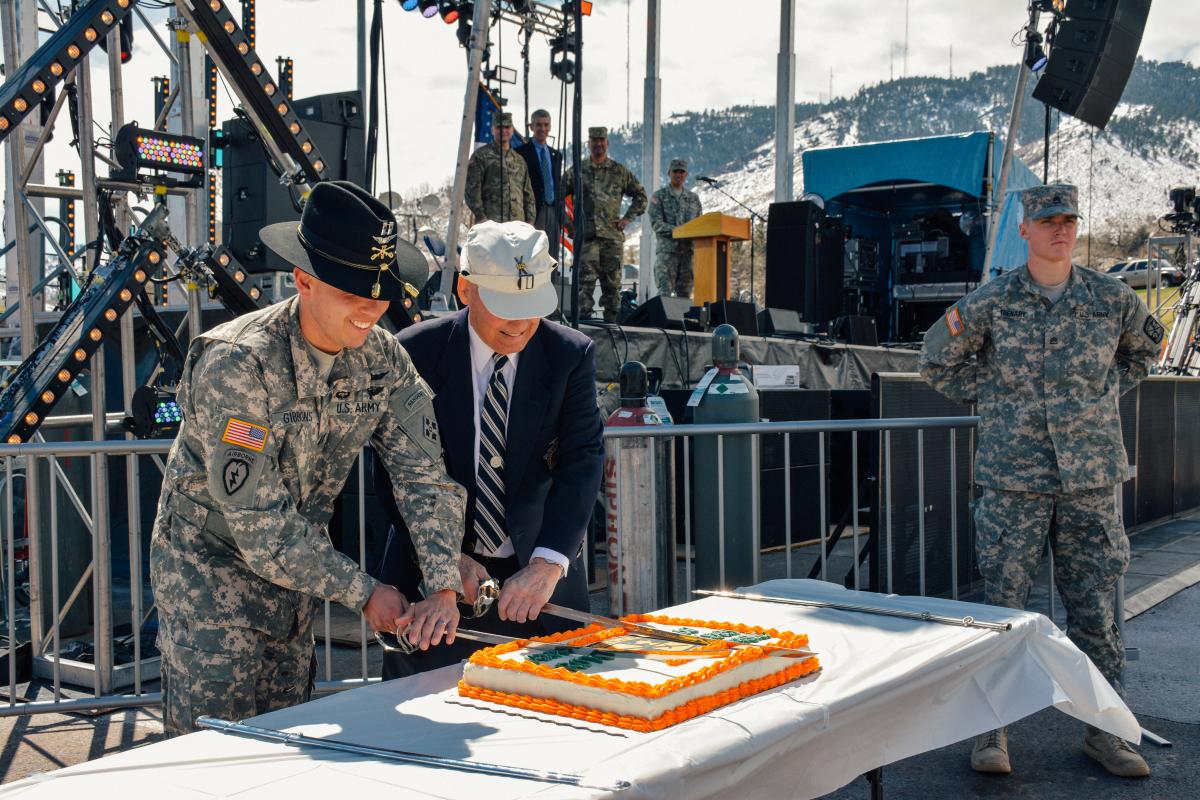 |
| Buffalo Battalion cadets prepare to board the Chinook Helicopter for a training exercise on the top of South Table Mountain. (Photograph by Luke Brown) |
100 years after the establishment of ROTC, Mines’ program remains a national stand-out.
Sixteen miles into the 2016 Bataan Memorial Death March, Army ROTC Cadet Parker Bolstad felt his quads seize up, and he collapsed to his knees. He was clad in a full military uniform and boots, a 40-pound pack on his back. The blazing sun beat down on him, and the hot desert sand of New Mexico’s White Sands Missile Range made the 80-degree day feel like 100. He was dehydrated and exhausted. But when a four-wheeler loaded with National Guardsmen drove up to pull him off the course, Bolstad instead filled his water bottle and kept running.
Ten miles later, he crossed the finish line at a time of 8:22:09, flanked by a crowd of cheering fellow cadets who had road- tripped from Mines to run either the 13.1-mile or 26.2-mile race in commemoration of World War II service members or cheer on their comrades from the sidelines. Inspired by the experience, Bolstad, a sophomore environmental engineering student, is now training other cadets for next year’s march. In a way, he says, it illustrates what ROTC is all about.
“It’s about showing yourself what you can do when you put your mind to it, and then helping others do the same,” says Bolstad. “It’s an incredible confidence builder.”
Established by Congress on June 3, 1916, the Reserve Officer Training Corps has for a century helped students like Bolstad earn degrees at top-tier civilian colleges and universities, while gaining resilience, discipline and leadership skills members say are not often emphasized in the traditional classroom. Awarding more than $431 million annually, ROTC is among the nation’s largest grantors of scholarships. Students can earn a generous aid package in exchange for committing to military science classes and physical and combat training during school, as well as a four to eight year service commitment (either active duty or in the U.S. Army Reserve) post-graduation.
As one of the first four schools in the nation to establish an ROTC program, and, until the 1970s, one of the only to make ROTC mandatory for all students, Mines has been integral to the program since its inception, producing more Army officers (2,400 to date) and receiving more accolades than schools twice its size. As ROTC celebrates its centennial, alumni say the program is as relevant today as ever.
“If you look around at our major political parties, and Congress, and certain areas of industry, many would argue that there is a crisis of leadership in this country right now,” says ROTC alumnus Paul Dorr ’74. “There is no better place to learn how to be a leader than ROTC.”
“The West Point of the Rockies”
 |
| Mines ROTC members present the colors in 1925. (Photograph courtesy of Prospector 1925) |
ROTC was officially established at Mines in 1919, under an authorization from the U.S. War Department. But the school’s close relationship with the U.S. military dates back to Mines’ inception.
As far back as 1873, students of what was then known as the “University Schools at Golden” could be found performing military exercises on campus under the leadership of decorated Civil War Captain George West. When Mines was officially founded one year later, the Military Department was among the first three departments established on campus.
“We have had Mines students in every war since 1874,” says ROTC University Liaison Fran Aguilar, as she tours a visitor through an office decorated with black and white photos and the retired, reddish battle ag of the 115th Engineers Regiment.
The precursor to Mines’ first ROTC Unit, the regiment was first established in 1909, making up one of the first engineering-focused infantries in the country. By August 1918, the regiment touched down in France amid the battles of World War I, where members put their combination of engineering skills and military savvy to work constructing and repairing roads, bridges and camps near the front lines.
The following year, with World War I drawing to a close, and the U.S. military eager to be prepared for future conflicts, it established an official ROTC unit at Mines, expressly to train graduates for the U.S. Army Corps of Engineers.
In the decades to come, aspiring students would refer to Mines as “The West Point of the Rockies” and generals would call the school “The backbone of the Corps of Engineers.”
“Very early on, the military recognized that the Mines graduate was a unique graduate. Our students come out of school prepared to go to work,” says Dorr, now an ROTC board member who also co-authored a comprehensive history of Mines ROTC.
A Hero Hall of Fame
Survey the roster of the Buffalo Battalion ROTC Alumni Hall of Fame (which recognizes distinguished graduates), and you find tale after tale of wartime heroics by Mines ROTC alumni:
Wendell Fertig ’24 famously refused to surrender to Japanese forces when they tried to occupy the island of Mindanao in the Philippines during World War II. Instead, he organized a successful U.S-Filipino guerilla force, installed a civilian government and built a communications network there. After the war, he came to Mines to head up the ROTC program.
Keith Comstock ’50 had already served on the India-Burma border during World War II and earned two bronze stars during the Korean War when he was commissioned to spearhead a top-secret CIA mission, Operation Gold, to build a quarter-mile tunnel on the border of East Berlin. According to press reports, the tunnel helped British intelligence officers tap into 1,200 phone lines, accessing 40,000 hours of conversations between the Soviet Union and East Germany during the early Cold War. Comstock wasn’t permitted to discuss his work with anyone, including his wife and children, until it was declassified in 2007, 52 years after it was completed.
Hugh Evans ’49 is one of the last surviving members of the U.S. Army’s famous 10th Mountain Division which trained in the Colorado Rocky Mountains to fight on the snow-packed terrain of Eastern Europe. He was a platoon sergeant in Italy during World War II, returned to Mines to get a master’s degree and join ROTC, then served again in the Korean War. At 92 years old, he still participates in a commemorative backcountry ski trip to his wartime training ground each year. When Mines was chosen to host a 100th anniversary celebration for ROTC in April 2016, he proudly cut the cake. “You can have a narrow life, or a deep and broad life,” says Evans. “ROTC gave me depth.”
The Vietnam Era
Mines graduates’ unique engineering skills continued to play a key role in the military theater during the Vietnam years. “You go into a triple-canopy jungle and there is no infrastructure. It has got to be built. Guess who built it. Our engineers,” says Paul Dorr.
But as the war dragged on and anti-war sentiment peaked, ROTC began to fall on hard times.
Amid a wave of student and faculty protests over the U.S. military’s involvement in the Vietnam War, Harvard University expelled ROTC from campus in 1968, prompting a host of other prestigious universities to follow suit. (Only recently has Harvard invited ROTC back to campus). At Mines, anti-war protests were less common, but a group of students did petition the state legislature to ask Mines to do away with its compulsory ROTC service. As a result, it was dropped in the early 1970s. After that, enrollment declined sharply from 768 members in 1968 to 387 members in 1974, before picking back up again slightly during the 1980s.
At one point, in 1991, the Army embarked on a plan to reduce the number of ROTC programs nationwide and pegged the Mines program for elimination, due to the school’s small size and a perceived lack of demand. But Bruce Goetz, then professor of military science, personally fought to keep the program on campus. He succeeded.
“The tradition of the citizen soldier has always been revered at Mines,” wrote Goetz, in the biography he presented for his recent induction into the Buffalo Battalion Hall of Fame. “There rests a quiet pride in the continuation of the tradition of military science here.”
Today, Mines is part of a 13-member Buffalo Battalion, which includes University of Colorado Boulder, Metropolitan State University of Denver, and other Front Range schools. In both 2013 and 2015, the battalion earned the U.S. Army Cadet Command’s MacArthur Award, recognizing it as one of the top eight programs in the nation.
Building Leaders, From Battlefield to Board Room
 |
| Air Force ROTC cadets stand in formation on the Veteran's Day Ceremony in November 2015. Front row: Andrew Blaney '16, Brandon Hall, John Boswell, Adam Nelson, Mary Bell. Row 2: Timothy Kelvin, Gary North, Timothy Cranor, Kristina Gately, Scott Kumjian. Row 3: Matthew Jaszai, Steven Mohan, Heidi Logsdon, Malek Awad. Row 4: Jason Loving, Chris Campbell, Luke Laroque, Justin Dollar. (Photograph courtesy of Mines ROTC) |
Those who joined ROTC in more peaceful times also say their experience shaped their lives in invaluable ways.
Paul Dorr, a Steamboat, Colorado, native whose parents collectively made less than $10,000 annually at the time, said ROTC’s financial generosity made it possible for him to attend college. After graduating in 1974, he spent four years on active duty in Hanau, Germany, aiding in the construction of bridges, and then another 16 years in the Army Reserve. Meanwhile, he built an illustrious career as a strategic planner and entrepreneur in the mining industry.
He credits his private sector success largely to the lessons he learned in the military. He learned how to communicate concisely, not only with subordinates, but also with superiors and “those on your left and right.” He also learned how important it is to take care of your employees. “I learned that you have to give people responsibility and training. But you also have to give them the authority to execute that responsibility. And then you have to hold them accountable for it,” says Dorr. “That’s true leadership, and too often it is not taught in business school.”
Janet Patev ’86 says she was attracted to ROTC because, unlike West Point and other U.S. military academies, it allowed her to get a taste of the military culture without being fully immersed in it or having to pledge right away to a post-graduation commitment. (ROTC members aren’t required to commit until their junior year).
“You could go to a [civilian] college and a few times a week put the uniform on. Most of the time, you felt like a regular student,” says Patev, who spent four years active duty post-graduation. She now works in a civilian position for the U.S. Army Corps of Engineers. Herein lies another perk she got from ROTC.
“If you want to be hired for a federal position, being a veteran is a huge benefit,” she says. “It helped me get my job.”
ROTC Today
 |
| CPT Ryan Gibbons '09 and Hugh Evans '49, one of the last surviving members of the 10th Mountain Division, cut the ROTC's 100th birthday cake. (Photograph by Kathleen Morton) |
When it comes to physical training, today’s Mines ROTC company is recognized as among the most physically fit in the nation. Members rise at 5 a.m. Four to five days a week for a rigorous workout (a perfect score on the physical training tests involves: 71 pushups in two minutes, 78 sit-ups in two minutes and a two mile run in 13 minutes or less.) Many climb, ski or run on the weekends, or—as Parker Bolstad did—crank their training up a notch by heading to competitions like the annual Bataan Memorial Death March.
Unlike cadets who came before them, ROTC members today aren’t certain who the enemy is or where they will face them.
“Because the world is so chaotic, we tell the cadets they will deploy somewhere in the world, but we have no idea where,” says Aaron Roof, the current professor of military science. “There is an emphasis on not what to think, but how to think—how to handle whatever complex task they are asked to deal with.”
And those tasks aren’t necessarily on the battlefield. In recent years, ROTC alumni have touched down in West Africa to help with the deadly Ebola outbreak, South Sudan to provide food to starving children and Haiti to aid earthquake survivors.
To John Kater, a mechanical engineering senior, ROTC has been a pleasant surprise.
In high school, he envisioned himself as a theologian and saw the army and the ministry as diametrically opposed. “I envisioned myself cleaning toilets with a toothbrush like they did in the old war movies,” says Kater, who changed his mind after attending an American Legion meeting. “I didn’t realize ROTC could help me become a more competent leader and more impactful in my community.”
Since arriving at Mines, Kater has gone to air-assault school in Georgia (where he learned how to rappel out of a helicopter), own to Moldova (between Russia and Ukraine) for a language and cultural understanding program, and completed a grueling 16- day combat training camp at Fort Knox, Kentucky.
Now as a senior, he looks forward to leading new cadets to the program. Looking back, the former “wild child” as he describes himself, says it helped him become more disciplined and responsible and changed his image of the military.
“I went from thinking of it as a band of fighters to thinking of it as a band of peacekeepers,” he says. “On occasion you have to fight to keep the peace.”
Reprinted from the fall 2016 issue of Mines Magazine, the Colorado School of Mines Alumni Magazine
Story by Lisa Marshall



